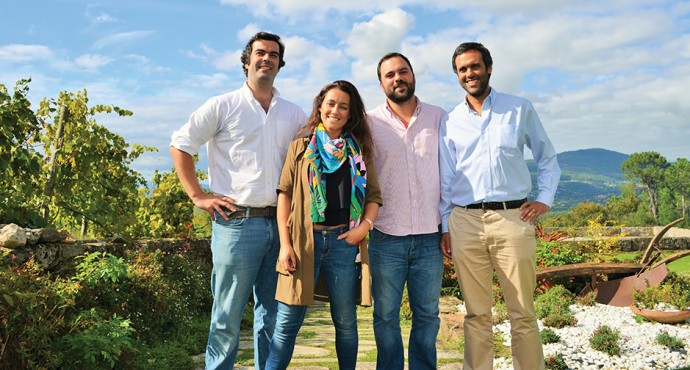In WAG’s December “Enduring Passion” issue, Doug Paulding, our Wine & Dine columnist and resident Bacchus, considers the tempest-in-a-wine-bottle bubbling in northern Portugal’s Vinho Verde region over the production and future of the sparkling vintage that bears the region’s name. Here he continues the story, recalling his visits with winemakers who are producing a more modern, crisper, less carbonated Vinho Verde:
“We visited a vineyard called MQ Vinhos in the very northern part of Vinho Verde just below the Spanish border mountains where we met four young (ish), wildly enthusiastic winemakers. Owner Miguel Queimado and his friends are part of a small group known as the Vinho Verde Young Project. Their total production is micro, but I think their effect will be significant. Combined they make just 44,000 bottles, but they are striving to produce food-friendly wines capable of improving with some age. Joana Santiago of Quinta de Santiago, along with João Camizão Rocha of 100igual winery and Vasco Magalhães of Cazas Novas are all striving to improve the wines and the perceptions of Vinho Verde wines. Vasco told me, ‘We are dropping the gas, lowering the acidity. We are trying something different than the typical fizzy Vinho Verde.’
“Our last night in the region we had dinner in the city of Porto, hosted by the Monteiro brothers of Quinta Das Arcas, who are taking another approach. They are one of the largest producers in Vinho Verde. The winery was founded just 30 years ago by their father, a driven man who continues to buy land and plant grapes. They are moving toward environmentally sustainable production and are making significantly better wines than just a decade ago. Antonio Monteiro told me, “Vinho Verde without CO2 is like a flat beer or a bubble-free soda. Take out the bubbles and it’s just a white wine. It’s the bubbles that make it Vinho Verde.”
“The Monteiros did say that regionally CO2 is being reduced, that CO2 had been used to mask flaws in the wine. Many years ago the government required all land owners to grow food crops, to help the country survive famine. Grape vines were relegated to the borders of the property and trained vertically, up tree trunks, high posts and even up the sides of buildings. Caring for and harvesting the grapes became a difficult and dangerous job. Commercially, these vines did not produce interesting or high flavor grapes and are not viable. Now they are being replanted, employing the traditional two- or three-wire trellising system anyone would recognize.”
Write Doug at doug@dougpaulding.com. – Georgette Gouveia

